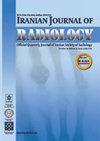Effectiveness of Uterine Arterial Embolization and Risk Factors Associated with Its Failure in Patients with Primary Postpartum Hemorrhage After Cesarean Section
IF 0.4
4区 医学
Q4 RADIOLOGY, NUCLEAR MEDICINE & MEDICAL IMAGING
引用次数: 0
Abstract
Background: Postpartum hemorrhage (PPH), a serious labor-related complication, is the leading cause of maternal mortality, which requires an emergent intervention. Uterine arterial embolization (UAE) is an effective treatment for hemostasis of intractable PPH. Several risk factors have been reported for the failure of UAE. Objectives: To evaluate the clinical outcomes of UAE for the treatment of primary PPH following cesarean section (CS) and to determine the risk factors associated with the failure of this procedure. Methods: This retrospective, single-center study was approved by the institutional review board, and the requirement to obtain informed consent was waived. All patients referred to a tertiary care center, who underwent UAE for primary PPH between January 2018 and December 2020, were included. The patients’ medical records and radiological findings, including the patients’ characteristics, mode of delivery, initial vital signs and laboratory findings after hospitalization, procedure details, and embolization outcomes, were evaluated for data collection. Technical success was defined as appropriate embolization of target vessels on a completion angiogram. Clinical success was defined as adequate cessation of bleeding after the first embolization, without any need for subsequent embolization or surgical intervention. Statistical analysis was performed to determine factors related to the clinical failure of UAE in CS cases. Results: UAE was performed for 25 patients (mean age, 37.2 years; range, 25 - 45 years). The technical success rate was estimated at 100% (n = 25), and the clinical success rate was 76% (n = 19). There were no patients with permanent adverse sequelae or death. The univariate analyses showed that hemodynamic instability (P = 0.006), lower hemoglobin levels (P = 0.02), and prolonged activated partial thromboplastin time (aPTT) (P = 0.017) were related to clinical failure. The logistic regression analysis adjusted for age showed that the area under the curve (AUC) was 0.86 for hemoglobin (95% CI: 0.7 - 1; cutoff value: 0.667), 0.816 for aPTT (95% CI: 0.625 - 1; cutoff value: 0.411), and 0.868 for hemodynamic instability (95% CI: 0.661 - 1; cutoff value: 0.622). Conclusions: UAE is a safe and effective treatment for primary PPH following CS. Hemodynamic instability, low hemoglobin levels, and prolonged aPTT can be predictive factors for the poor outcomes of UAE in CS patients. These factors are rapid and straightforward criteria, which can be simply applied, even in emergency situations.子宫动脉栓塞治疗剖宫产术后原发性产后出血的疗效及失败的危险因素
背景:产后出血是一种严重的分娩并发症,是导致产妇死亡的主要原因,需要紧急干预。子宫动脉栓塞(UAE)是治疗顽固性PPH止血的有效方法。据报道,阿联酋的失败有几个风险因素。目的:评估UAE治疗剖宫产术后原发性PPH的临床疗效,并确定与该手术失败相关的危险因素。方法:这项回顾性的单中心研究获得了机构审查委员会的批准,并放弃了获得知情同意的要求。所有在2018年1月至2020年12月期间因原发性PPH接受阿联酋治疗的转诊至三级护理中心的患者都包括在内。评估患者的医疗记录和放射学检查结果,包括患者的特征、分娩方式、住院后的初始生命体征和实验室检查结果、手术细节和栓塞结果,以收集数据。技术上的成功被定义为在完成血管造影时对目标血管进行适当的栓塞。临床成功被定义为在第一次栓塞后充分止血,无需任何后续栓塞或手术干预。进行统计分析以确定CS病例中与UAE临床失败相关的因素。结果:25例患者(平均年龄37.2岁;范围25-45岁)接受了UAE检查。技术成功率估计为100%(n=25),临床成功率为76%(n=19)。没有患者出现永久性不良后遗症或死亡。单变量分析显示,血液动力学不稳定(P=0.006)、血红蛋白水平降低(P=0.02)和活化部分凝血活酶时间延长(aPTT)(P=0.017)与临床失败有关。经年龄调整的逻辑回归分析显示,血红蛋白的曲线下面积(AUC)为0.86(95%CI:0.7-1;截止值:0.667),aPTT的曲线下区域为0.816(95%CI:0.625-1;截止值为0.411),血流动力学不稳定的曲线下区域为0.868(95%CI:0.661-1;截止数值:0.622)。结论:UAE是CS后原发性PPH的安全有效治疗方法。血液动力学不稳定、血红蛋白水平低和aPTT延长可能是CS患者UAE不良预后的预测因素。这些因素是快速而直接的标准,即使在紧急情况下也可以简单地应用。
本文章由计算机程序翻译,如有差异,请以英文原文为准。
求助全文
约1分钟内获得全文
求助全文
来源期刊

Iranian Journal of Radiology
RADIOLOGY, NUCLEAR MEDICINE & MEDICAL IMAGING-
CiteScore
0.50
自引率
0.00%
发文量
33
审稿时长
>12 weeks
期刊介绍:
The Iranian Journal of Radiology is the official journal of Tehran University of Medical Sciences and the Iranian Society of Radiology. It is a scientific forum dedicated primarily to the topics relevant to radiology and allied sciences of the developing countries, which have been neglected or have received little attention in the Western medical literature.
This journal particularly welcomes manuscripts which deal with radiology and imaging from geographic regions wherein problems regarding economic, social, ethnic and cultural parameters affecting prevalence and course of the illness are taken into consideration.
The Iranian Journal of Radiology has been launched in order to interchange information in the field of radiology and other related scientific spheres. In accordance with the objective of developing the scientific ability of the radiological population and other related scientific fields, this journal publishes research articles, evidence-based review articles, and case reports focused on regional tropics.
Iranian Journal of Radiology operates in agreement with the below principles in compliance with continuous quality improvement:
1-Increasing the satisfaction of the readers, authors, staff, and co-workers.
2-Improving the scientific content and appearance of the journal.
3-Advancing the scientific validity of the journal both nationally and internationally.
Such basics are accomplished only by aggregative effort and reciprocity of the radiological population and related sciences, authorities, and staff of the journal.
 求助内容:
求助内容: 应助结果提醒方式:
应助结果提醒方式:


